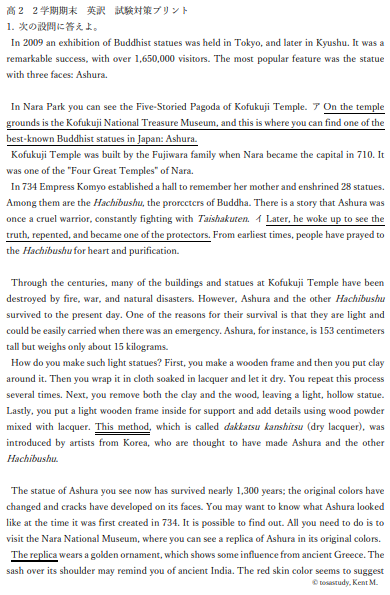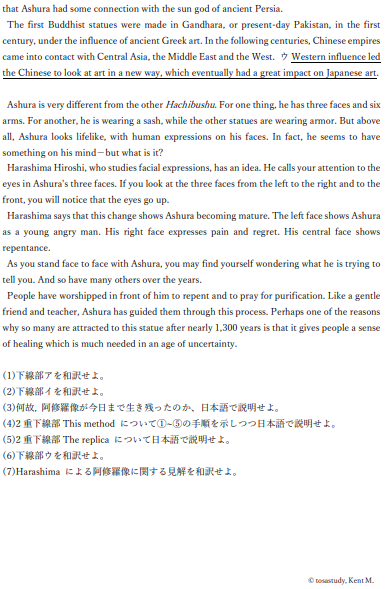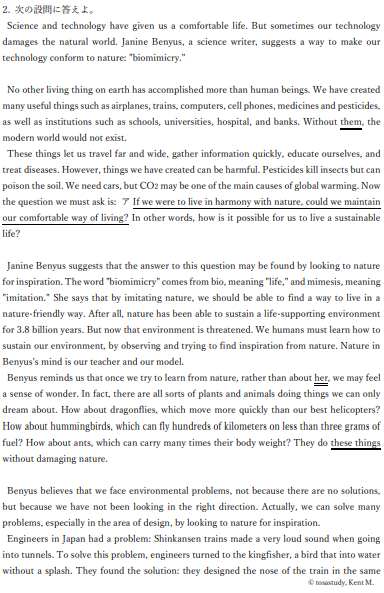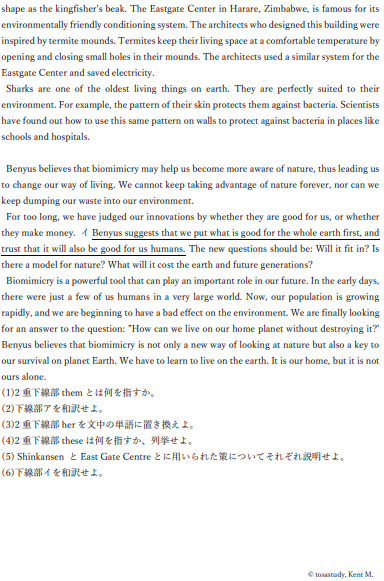Tosastudy-engl
1.例文①
In 2009 an exhibition of Buddhist statues was held in Tokyo, and later in Kyushu. It was a remarkable success, with over 1,650,000 visitors. The most popular feature was the statue with three faces: Ashura.
In Nara Park you can see the Five-Storied Pagoda of Kofukuji Temple. On the temple grounds is the Kofukuji National Treasure Museum, and this is where you can find one of the best-known Buddhist statues in Japan: Ashura.
Kofukuji Temple was built by the Fujiwara family when Nara became the capital in 710. It was one of the "Four Great Temples" of Nara.
In 734 Empress Komyo established a hall to remember her mother and enshrined 28 statues. Among them are the Hachibushu, the prorcctcrs of Buddha. There is a story that Ashura was once a cruel warrior, constantly fighting with Taishakuten. Later, he woke up to see the truth, repented, and became one of the protectors. From earliest times, people have prayed to the Hachibushu for heart and purification.
Through the centuries, many of the buildings and statues at Kofukuji Temple have been destroyed by fire, war, and natural disasters. However, Ashura and the other Hachibushu survived to the present day. One of the reasons for their survival is that they are light and could be easily carried when there was an emergency. Ashura, for instance, is 153 centimeters tall but weighs only about 15 kilograms.
How do you make such light statues? First, you make a wooden frame and then you put clay around it. Then you wrap it in cloth soaked in lacquer and let it dry. You repeat this process several times. Next, you remove both the clay and the wood, leaving a light, hollow statue. Lastly, you put a light wooden frame inside for support and add details using wood powder mixed with lacquer. This method, which is called dakkatsu kanshitsu (dry lacquer), was introduced by artists from Korea, who are thought to have made Ashura and the other Hachibushu.
The statue of Ashura you see now has survived nearly 1,300 years; the original colors have changed and cracks have developed on its faces. You may want to know what Ashura looked like at the time it was first created in 734. It is possible to find out. All you need to do is to visit the Nara National Museum, where you can see a replica of Ashura in its original colors.
The replica wears a golden ornament, which shows some influence from ancient Greece. The sash over its shoulder may remind you of ancient India. The red skin color seems to suggest that Ashura had some connection with the sun god of ancient Persia.
The first Buddhist statues were made in Gandhara, or present-day Pakistan, in the first century, under the influence of ancient Greek art. In the following centuries, Chinese empires came into contact with Central Asia, the Middle East and the West. Western influence led the Chinese to look at art in a new way, which eventually had a great impact on Japanese art.
Ashura is very different from the other Hachibushu. For one thing, he has three faces and six arms. For another, he is wearing a sash, while the other statues are wearing armor. But above all, Ashura looks lifelike, with human expressions on his faces. In fact, he seems to have something on his mind−but what is it?
Harashima Hiroshi, who studies facial expressions, has an idea. He calls your attention to the eyes in Ashura's three faces. If you look at the three faces from the left to the right and to the front, you will notice that the eyes go up.
Harashima says that this change shows Ashura becoming mature. The left face shows Ashura as a young angry man. His right face expresses pain and regret. His central face shows repentance.
As you stand face to face with Ashura, you may find yourself wondering what he is trying to tell you. And so have many others over the years.
People have worshipped in front of him to repent and to pray for purification. Like a gentle friend and teacher, Ashura has guided them through this process. Perhaps one of the reasons why so many are attracted to this statue after nearly 1,300 years is that it gives people a sense of healing which is much needed in an age of uncertainty.
2.例文②(日本語訳)
3.例文②
Science and technology have given us a comfortable life. But sometimes our technology damages the natural world. Janine Benyus, a science writer, suggests a way to make our technology conform to nature: "biomimicry."
No other living thing on earth has accomplished more than human beings. We have created many useful things such as airplanes, trains, computers, cell phones, medicines and pesticides, as well as institutions such as schools, universities, hospital, md banks. Without them, the modern world would not exist.
These things let us travel far and wide, gather information quickly, educate ourselves, and treat diseases. However, things we have created can be harmful. Pesticides kill insects but can poison the soil. We need cars, but CO2 may be one of the main causes of global warming. Now the question we must ask is: If we were to live in harmony with nature, could we maintain our comfortable way of living? In other words, how is it possible for us to live a sustainable life?
Janine Benyus suggests that the answer to this question may be found by looking to nature for inspiration. The word "biomimicry" comes from bio, meaning "life," and mimesis, meaning "imitation." She says that by imitating nature, we should be able to find a way to live in a nature-friendly way. After all, nature has been able to sustain a life-supporting environment for 3.8 billion years. But now that environment is threatened. We humans must learn how to sustain our environment, by observing and trying to find inspiration from nature. Nature in Benyus's mind is our teacher and our model.
Benyus reminds us that once we try to learn from nature, rather than about her, we may feel a sense of wonder. In fact, there are all sorts of plants and animals doing things we can only dream about. How about dragonflies, which move more quickly than our best helicopters? How about hummingbirds, which can fly hundreds of kilometers on less than three grams of fuel? How about ants, which can carry many times their body weight? They do these things without damaging nature.
Benyus believes that we face environmental problems, not because there are no solutions, but because we have not been looking in the right direction. Actually, we can solve many problems, especially in the area of design, by looking to nature for inspiration.
Engineers in Japan had a problem: Shinkansen trains made a very loud sound when going into tunnels. To solve this problem, engineers turned to the kingfisher, a bird that into water without a splash. They found the solution: they designed the nose of the train in the same shape as the kingfisher's beak. The Eastgate Center in Harare, Zimbabwe, is famous for its environmentally friendly conditioning system. The architects who designed this building were inspired by termite mounds. Termites keep their living space at a comfortable temperature by opening and closing small holes in their mounds. The architects used a similar system for the Eastgate Center and saved electricity.
Sharks are one of the oldest living things on earth. They are perfectly suited to their environment. For example, the pattern of their skin protects them against bacteria. Scientists have found out how to use this same pattern on walls to protect against bacteria in places like schools and hospitals.
Benyus believes that biomimicry may help us become more aware of nature, thus leading us to change our way of living. We cannot keep taking advantage of nature forever, nor can we keep dumping our waste into our environment.
For too long, we have judged our innovations by whether they are good for us, or whether they make money. Benyus suggests that we put what is good for the whole earth first, and trust that it will also be good for us humans. The new questions should be: Will it fit in? Is there a model for nature? What will it cost the earth and future generations?
Biomimicry is a powerful tool that can play an important role in our future. In the early days, there were just a few of us humans in a very large world. Now, our population is growing rapidly, and we are beginning to have a bad effect on the environment. We are finally looking for an answer to the question: "How can we live on our home planet without destroying it?' Benyus believes that biomimicry is not only a new way of looking at nature but also a key to our survival on planet Earth. We have to learn to live on the earth. It is our home, but it is not ours alone.
4.例文②(日本語訳)
5.予想問題





6.予想問題・解答





7.ダウンロードリンク
予想問題のリンクはこちら